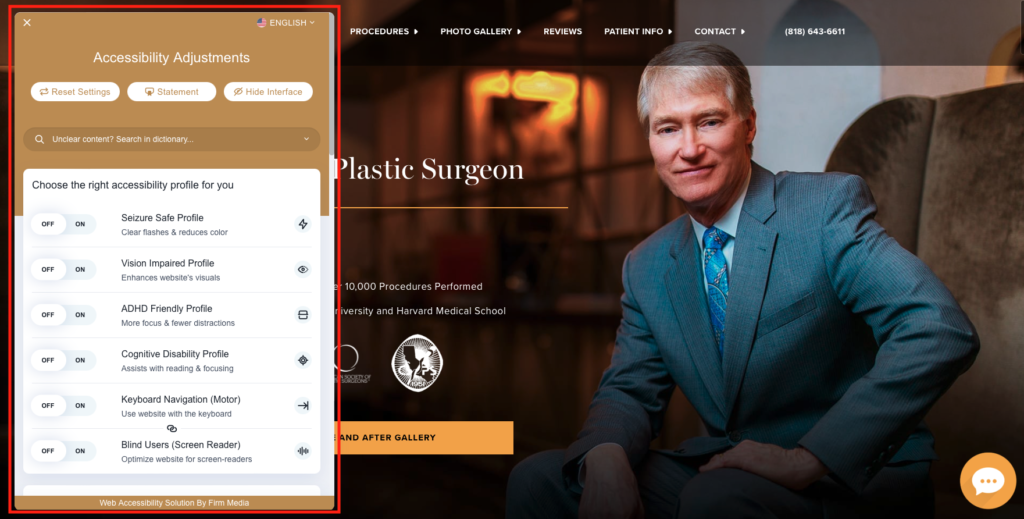What Is Web Accessibility?
Web accessibility is essentially a set of rules, behaviors, code standards, and design guidelines created by the W3C and called the WCAG 2.1. The WCAG 2.1 is a massive 1,000-page guidebook that encapsulates a range of disabilities that go from hindering internet use to making internet use impossible without accommodations. This spectrum comprises 20-25% of the general population, depending on if we’re going with the CDC or WHO. There are many disabilities covered, and the primary categories that require attention are:
- Blind people using screen-readers
- Motor-impaired using only the keyboard to navigate
- Epilepsy and color blindness
- Cognitive and learning disabilities
- Visual impairments and more
The WCAG 2.1 at the AA level has been adopted as the global standard for web accessibility acting as the benchmark in legislation such as the ADA title 3, Section 508, AODA, EN 301549, and many others.
Why Does It Matter To Your Medical Practice?
ADA compliance lawsuits are on nothing short of an intense rise. 200% year over year, with reports of 10’s of thousands of demand letters and threatened lawsuits, and actual litigation, targeting businesses of all sizes, including medical practices like yours. At first, only the largest of enterprises and government institutions were legally pressured to become accessible, which makes sense. One of the most significant shifts in the legal climate was when the DOJ at the end of 2018 officially affirmed that all websites are considered public accommodations and therefore must comply with title 3 of the ADA. Many did not think for a second that it will ever happen to them, but that has not been the case.
In fact, 2019 ended up tripling 2018 in the number of papers served. This means that for every business hour in 2019, a business was served for not being web accessible. You will also find that in almost every situation, the plaintiff wins the case on its merits because it’s a strict liability law and judges are often understandably sympathetic to people with disabilities who want equal rights. There is little chance of winning an ADA case when you are not ADA compliant. Many lawyers simply advise their clients to write a check since there is rarely a reason to fight it.
Is Your Website ADA Compliant?
Unfortunately, the answer to this question is complicated. When it comes to compliance, it is important to remember that it is not a pass-fail test. There is no sticker or gold star. Rather, it is a spectrum; a website can be more compliant or less compliant. The more compliant a website is, the lower risk there is for a demand letter or a lawsuit that is typically settled or lost at trial.
That is why since 2019 our team has proactively taken reasonable steps to make our client’s website as accessibility friendly as possible. Some of the steps we take with website design include, but are not limited to:
- Providing alt text for images that can be read by a screen reader
- Creating strong color contrast
- Creating more than one indicator for links and hover states
- Making sure text size is legible on all devices and screen sizes
- Creating consistent navigation that is the same from page to page
- Creating forms that have clearly labeled fields and indicators
- Making sure there are multiple ways to access different pages/information on a website (e.g. search bar, nav menus, sitemap, breadcrumbs, helpful links after content)
It is also important to note that one of the legal requirements of being ADA compliant is to have a statement that highlights your website’s accessibility. We have included an accessibility page on our clients’ websites, which can be found in the footer of every page of the website. This page states:
“Our goal is to provide a website that is accessible to everyone. We continually review and modify our site to improve its accessibility for people with disabilities and those who use assistive technology.”
This disclaimer is important because it recognizes that accessibility/ADA guidelines are ever-changing, meaning though we are continually monitoring and working towards being accessibility friendly for your patients, you will likely at any given time never truly be 100% compliant.
A sample of the accessibility disclaimer can be viewed here.
How Can Your Medical Practice Decrease Your Legal Liability?
One thing we would like to make abundantly clear is taking reasonable steps to be ADA compliant does not absolve you of the possibility of a lawsuit or threatening letter from a plaintiffs attorney. However, we have worked toward implementing a tool that was created side by side with leading experts in accessibility and assistive technologies in an effort to provide one of the highest success rates in the industry with respect to going above and beyond the standards for compliance. The benefits of implementing our tool on your website include:
- Complies with ADA, Section 508, WCAG, AODA, ACA, IS5568, and more
- Powered by AI, the tool using contextual understanding and image
recognition to scan and analyze the functionality of every element on your
website and adjusts it for screen reader accessibility - Only takes 48 hours for AI to scan your website and fix accessibility-related
issues in the Content Management System using just a single line of code - Scans every 24 hours to search for new and revised content to make
accessibility friendly - Professional compliance audits executed every month looking for issues that
could not be automatically solved to keep an accurate record of your liabilities

How Much Does This Tool Cost Your Medical Practice?
Firm Media strongly urges you to consider opting in to utilizing our accessibility tool on your website. Fees for implementing this solution start at a yearly licensing fee of $500 as well as an ongoing monthly fee of $75, both of which are scalable due to website size and are subject to change.
Please note, should you choose not to opt in to utilizing this tool, we feel your medical practice is at greater risk for accessibility-related litigation.
If you would be interested in learning more about how Firm Media can provide your medical practice with an accessibility-friendly website experience, please call our office at (855) 912-0573 today. If you would like to schedule a Zoom with one of our marketing specialists, please click here.



